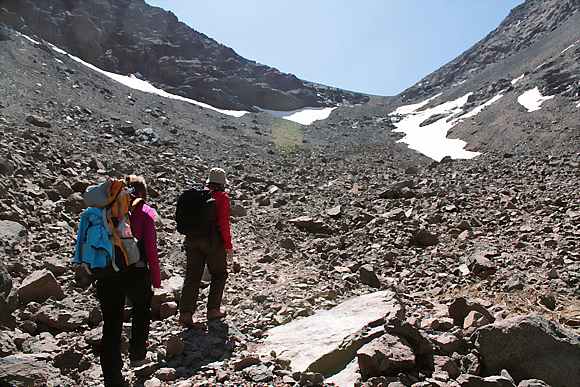OVER OVER EDGE OF MOROCCO - TREKKING TO Toubkal in the High Atlas

VagabondJourney.com by Pierre Laurent (Toubkal summit / Atlas Mountains, Morocco, October 13, 2012) - We fled Marrakech less than 24 hours after our arrival. The grand taxi station was not very hard to find: a small taxi took us there for less than $ 1. From there, we wanted to reach Imlil, a small village which is the starting point of the hike that leads to the highest summit of Morocco, Toubkal.
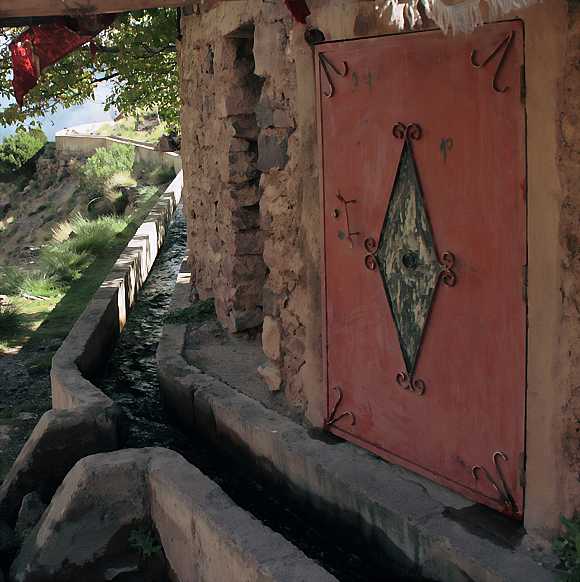
The station was on the border between Marrakech and the countryside: it was a kind of wasteland where people were selling fruits and vegetables. The smell of gasoline was filled the air. A dozen old cars Mercedes-colored sand were parked in the parking lot. Their drivers were chitchatting together in the shade of the fruit stall. Before my foot hits the ground, they are literally teleported next to us, asking: "Where are you going?" After a good deal smaller we were driving east, towards the mountains lost in the mist.
The counter displays antique Mercedes 962.421 km, but did not move. The Hand of Fatima was suspended mirror, dancing to the rhythm of turns. The desert landscape environment Marrakech quickly became mountainous and thinner road cone as it again and again moved through the laces. Sometimes we could see mules and their drivers on the side of the road and mopeds elders, but they have all disappeared in the blink of an eye. More we move towards Imlil road became worse, and she quickly turned into a dirt track covered with potholes.
Watch the movie the climb at: http://youtu.be/yHZU9UxnUA4
Imlil is a small village which is perched 5,500 feet above the sea new buildings standing next to traditional ones. Chain of the High Atlas where the second highest peak in Africa, Toubkal climbs it extends away from the north to south in the eastern part of Morocco, parallel to the Atlantic coast. We met Luis there, the Spanish guy walked with us for part of the hike.
Imlil
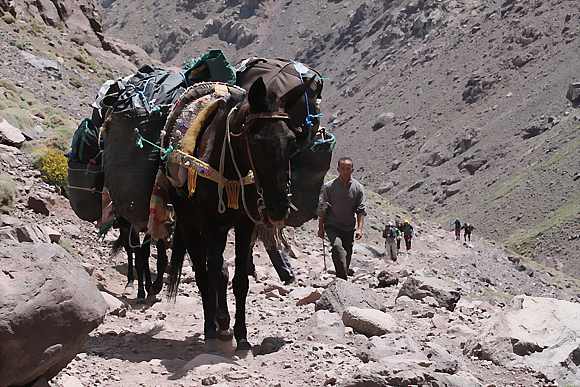
The dawn was near and fresh air when we woke up. The village seemed to be a ghost town in the fog surrounding. We met Luis, and drank tea to wake up and warm up before we start our hike. Then it was just a matter of following the path that was winding through the mountains. The fog covered everything: it was impossible to see anything more than 50 meters. We could hear the sound of a river roaringdown the mountain, but the bed was lost in the mist.
After a while, we passed hundreds of meters along the bottom of a valley carved by a glacier long ago. The stones rolled under our shoes, and the fog began to clear, allowing the landscape to appear. We could finally see the peaks around us: peaks and torn covered by snow here and there. Then we took the small road near a sign that said "You are now entering the natural park of Toubkal."
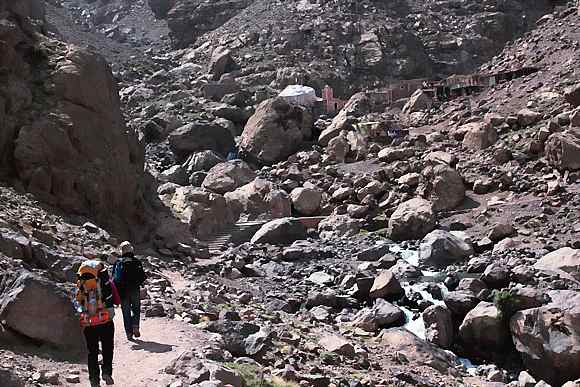
At this time, a Moroccan perched on a mule and muleteer surprised us: "You should get a mule like me, it's easier," laughed the man on the mule. We did not want to take guide or mules to carry our stuffs: it was too expensive for something we could do ourselves. Whilst we would be able to enjoy the scenery better if we just had a small backpack transport, but the rewards at the end would not be the same. would have been like to do something halfway: Hiking is not only walking, carrying your equipment is part of the equation.
It is possible to rent a mule and muleteer is to conduct your business during the trek (Photo: Natalia Belzarova)
The more we walked, the more the landscape becomes hard and stiff. Imlil and green surroundings slowly gave way to a land of rocks. The sky was bright blue and only a few clouds were quickly passed like a breeze blowing summer.
Natalia Luis and I took a short break, but sat most of the time without any word. Although we try to get our breath we watched the mountains around us we could see a few sheep on the other side of the valley, a few green patches here and there.
During one of the breaks theses, the mule and the guy perched on the mule appeared. How the hell do we overcome! When they passed the second time in front of us, the man on the mule research in one of the bags that hang on the side of the mule, dug an orange and threw it to me with a big smile on his face .
After three or four hours of walking, a small village came out of nowhere at the end of a small circus. Small buildings were the same color as the stones around him, and blended into the landscape. Only the Red Mosque visibly increased on the rocks. Before getting there, we had to cross a small bridge straddling a bubbling icy-blue river. Some people seem to live there, three hours walk from the nearest village.
While we stopped for a drink of water, one of the villagers approached us. It was surreal to speak in the mountains of Morocco in the French presidential elections that took place a few days ago. While the conversation was going well, he asked us if we had something to barter with him.
The small village hidden halfway
We do not know, but we were midway. As we advanced, we met hikers who were increasingly returning to Imlil each meeting was a good excuse to stop and exchange a few words. Exchange theories have always been the same themes: "The refuge far from here?" Or "Do you do until the top?"
Response on the top has never changed: "Too cold, too windy. It was not possible ..."
One thing is really surprising, but reveling in the excursion: it is as if the people who are walking on the same path all seem to be part of the same village. Everyone says hello to the people who come from, they can exchange a few words and a smile to another. It is very possible, well, that's the truth, if they were bumping into each other in a street in a city they do not talk to each other, or even smile. It may be the feeling of sharing something in common that bring hikers together, it may be a deep need to talk when he is lost in nature ... The thing is, it's really nice to share a little time with strangers, and it is never easy when you 'll walk on a footpath.
Westerners have lost this ability was not so long ago, when the majority of people have moved to the cities, where the media started becoming more developed and accessible. We began to be taught to fear strangers and create our own little world separate from the rest of society - but perhaps that is not voluntary ...
Luis and Natalia, who were a little ahead of me on the road, stopped to talk with two people who were about 50 years old. They were Danish. The man was sitting on a rock, his hair was long and unkempt and he seemed a little groggy. I realized why when he showed us his hands.
"He did it to the top alone without gloves, without proper equipment. This is frostbite. Has some on his legs too," said his wife, who had not joined in his adventure had waited in the shelter.
The mention of the possibility of frostbite and a strong wind began to dig a path violently in my head: if we are not very careful and try to reach the summit with our poor equipment there was a chance .. .
We followed the valley which was to shelter and at the end of each turn, at the bottom of each slope, I was hopping to see the little house would mean the end of our first step. We were close to 10,000 feet high, and our bags £ 33 seemed heavier and heavier. The last hour of the climb was the most intense. Finally, after a last bend, the end of the valley appeared. A stream going through a green meadow that stretched before us insofar as the two buildings of refuge. They were surrounded between two huge mountains that have faced each other. It was like the ultimate end of the world.
It was both beautiful and frightening.
The hiss of some rare birds passing by and the sound of rolling rocks beneath our boots were the only thing to break the silence. I no longer feel the pain in my legs, as we finally arrived at the end of our first stage, 10,521 feet above sea
After a good shower, we sat in the common room of the shelter where we learned more about what happened on the mountain in the previous days. We heard stories of all attempts have failed to reach the summit of Toubkal.
We befriended a couple of young hikers French who had tried for two days to the summit. They tried twice now without success. The first time they left about 6 or 7 am with a man and his 6 year old son. The wind was strong and raised the dust and sand from the ground and blowing into their eyes, ears, and the folds of their clothes. Many times they told us they had to take control of the 6 year old boy to prevent being swept away by a gust of wind. They finally decided to turn back and return to the refuge.
As we continued to hear about failed attempts over the top I will climb the mountain one person has weakened today: Danish, we met on the road with frostbite. He eventually staggered into the hut, groggy and half frozen.
When dinner was over, I went outside to smoke a cigarette in the twilight sky orange. There was no wind, not even a cloud. "It is time to go," joked one of the guides who were outside with me. Another said: "It is a good omen for tomorrow." I was not sure I'd be so happy about it.
When I woke up the next morning, the first thing I did was look out the window. There was sun, no wind at all. We took our breakfast in the refuge, which was now empty every hiker had left to return to Imlil. We made our choice today, we will climb onto the roof of Morocco!
Rocks and snow
We started the climb following the advice given to us by the French guy we met yesterday. The path was easy to see. My thoughts are concentrated on the top, but sometimes a glance of fear encouraged me to go down.
We only had one day to climb the 3200 feet that stood between us and the summit of Toubkal. Fairly quickly, we started to go back to hikers refuge: their eyes shone and they smiled as they talked about the summit. Once again, the many discussions we have to take extra breaks: the lack of oxygen has stolen our strength and we found ourselves constantly short of breath.
From the beginning, we crossed small patches of snow. More we climbed, the more they became, reminding us that winter and cold are not so far away. Some of these pieces have been creating small waterfalls, small rivers winding and hidden under the ice. From time to time, some birds flew over us: they joked about our slowness, our fatigue, our determination, we made our bid for the summit. A desert of stones, steep cliffs and peaks surrounding us so far. And, as always, a slope that seemed to go up to the blue sky stood before us.
Luis and me in the last part of the ascent. (Photo: Natalia Belzarova)
Why am I doing this? Why are we trying so hard to get? Why do we torture them to reach the top of a mountain?
The pleasure is in the first answer that came to my mind: this is the goal, this is the way which is satisfactory, the building experience.
This is true for this hike is also true for most events, trips, or quests that we encounter in life. Consecration tried over and over again is a trap. According to legend, the Holy Grail has never been recovered. Nevertheless, the knights who sought for decades it covers a huge amount of space, both physical and spiritual. On the road, long and dangerous, they are rich, they met people they grew up. They faced the trials they never thought they had remained in barley beer drinking Roundtable. This quest was only a pretext to occupy their passion, a dream of hunting a quest for an inheritance. In my case, this summit was also a dream, and I knew subconsciously that another goal would pick me up and drive me forward after I did there.
When we finally saw the sign that marks the summit of the mountain, it was a great relief. We did, I did. The last half hour was the most exhausting, physically and mentally than any other. As before, the slope of each line on the sky, promising a high lying beyond. Many times, I really thought I was really close, but it was in vain, for the upward slope kept rising. I walked to the speed of a grandmother invalid - bent under the effort - and I breathed as I was running a marathon. Every five minutes, despite the mental effort that I was otherwise, and the effect of group was me, I had to stop to catch my breath. But I was just looking in the direction of the summit. Nobody spoke more faces only were exchanged, a kind of smile stretched between two breaths. The idea of giving me beat my will to the end, until we finally arrived at the top.
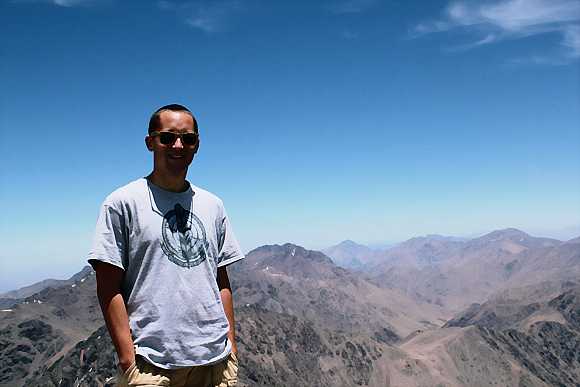
What a beautiful t-shirt, huh? In addition to the Toubkal.
After turning the pyramid steel hideous that marked the culmination appeared. Despite my fatigue, burning muscles, and shortness of breath, I accelerated. After a cry of relief and joy, we were 13,671 ft in peace.
There was only a slight breeze, and we sat and ate. Some birds wanted to steal our food. On one side we could see the plain of Marrakech and the other was all mountains and valleys, run and run until a vast expanse of desert. Few words were exchanged, but many smiles have been exhausted between us. We enjoyed the deafening silence that surrounded us.
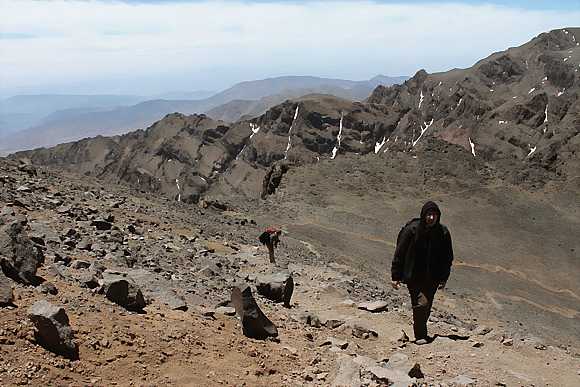
After ten minutes of meditation and napping, we began the long walk down. In the last quarter, we met some hikers who were walking with huge bags on their shoulders. "Are you going to camp up there?" I asked stupidly. "No, we go paragliding," one of them replied. Finally, we humans could return taunting birds.
morocco culture,moroccan food,morocco food,moroccan cuisine,morocco beaches,moroccan meal,beaches in morocco,moroccan culture,hercules cave,hercules cave morocco

















